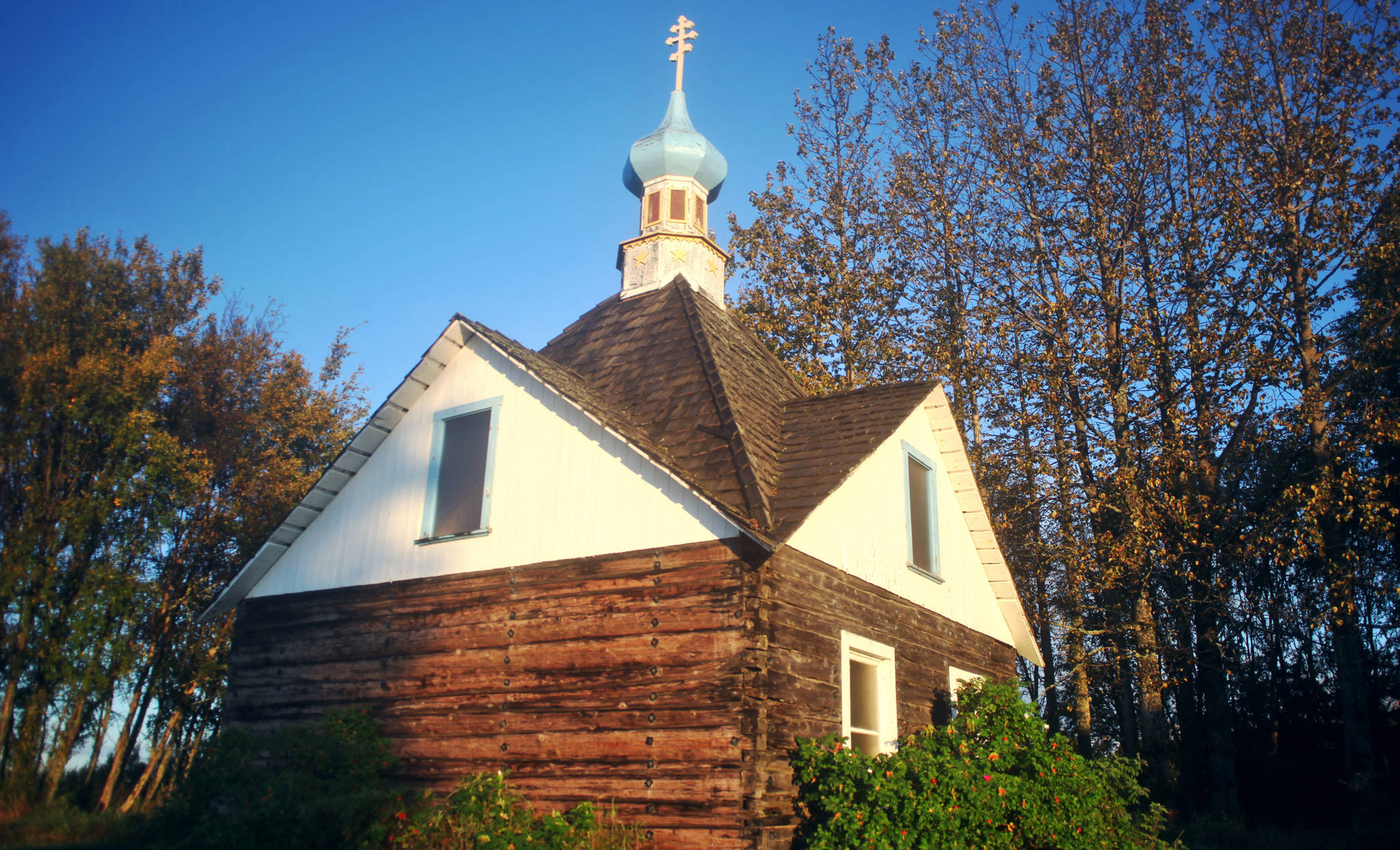Some of the square-hewn timbers of the small Russian Orthodox chapel in Old Town Kenai may be exchanged for fresh wood during a planned restoration project by Kenai’s Holy Assumption of the Virgin Mary Russian Orthodox church.
The church congregation recently received $12,500 from the nationwide Russian Orthodox philanthropic organization Fellowship of Orthodox Christians in America for restoring the chapel, a finishing step in renovation efforts the church has been pursuing since 2008.
“Unusual among Alaskan Russian Orthodox chapels, the Chapel of St. Nicholas is larger and more elaborate than most shrines, with its tall pyramidal roof and cross gable, yet smaller and plainer than most chapels, with its unfinished log interior,” noted historian Alice Hoagland in a 1990 report on the chapel for the Historic American Buildings Survey.
The chapel cost $300 to build in 1906 when Kenai residents erected it over the graves of Kenai’s first resident priest Egumen Nicholai, his assistant Makarii Ivanov and an unknown third monk.
Since then, the building — along with the main Holy Assumption Church and its rectory — has been entered in the National Registry of Historic Places, but repairs to it have been irregular over the years. Hoagland’s report states the chapel got a new foundation of concrete blocks in 1973, and “emergency stabilization work” in the late 1980s, when upright half-logs were bolted into the corners to hold up the walls. Congregation member Dorothy Gray, who’s also treasurer of the preservation nonprofit Russian Orthodox Sacred Sites in Alaska, said the windows have also been replaced, though in the 40 years that she’s been a member of the church, the only work she recalled on the chapel was by congregation member Ernie Jordan, who borrowed a Homer Electric Association bucket truck to ascend to the top of the onion dome to replace the three-armed cross on top.
Now chapel’s logs are weathered, and much of the moss chinking that originally sealed the space between them has fallen away, making the congregation’s one annual service in the chapel — the Dec. 19 feast of St. Nicholas, which they’ve been celebrating there since 2015 — a chilly and drafty event. The church plans to repair or replace the logs and chinking.
“And the roof,” Gray said. “And the dome and the cross all need to be repaired. Just about everything on the chapel needs repair.”
At its annual convention, the Russian Orthodox philanthropic organization Fellowship of Orthodox Christians in America chooses a cause to receive donations made throughout the year from individuals and churches in the group. This year’s cause is a pair of Orthodox churches in Texas damaged by Hurricane Harvey. Last year, the group’s fundraising cause was the restoration of Kenai’s Saint Nicholas chapel. At this year’s convention in Pennsylvania, they presented Gray with the $12,500 earned during the campaign. Grey said the church plans to try doubling the Fellowship donation through local fundraising, and use that amount to seek a matching grant from the Rasmuson Group, an Anchorage-based philanthropic fund, for a total restoration budget of $50,000.
Working out the nuts and bolts of the restoration project will be done with technical consultation from the National Park Service. Park Service Historical Architect John Wachtel said that as a site in the National Registry of Historic places, the chapel restoration would be planned according to the Secretary of the Interior’s Standards for the Treatment of Historic Properties.
A long journey
The chapel project, along with efforts underway to fix leaks in the main church’s roof, will be the final pieces of a thorough renovation the church began in 2008. Prior to that, Gray said the church’s main building was in poor shape.
“The foundation was crumbling in places,” she said. “The log walls were deteriorated around the windows to the point where you could reach in and it was like sawdust — you could crumble it with your fingers. The weight of the roof was making the side walls bow out, because the roof was pressing down and the logs around the bottom had gotten wet. And the heating system was antiquated to the point where it was damaging to the icons and artifacts — the heat would turn up and go down low. There wasn’t a consistent temperature in the building. There is now, thanks to the in-floor heating.”
In addition to strengthened walls and new heating, the church has installed a handicap access ramp, a security system, and sophisticated fire suppression that Gray said should online sometime this fall. The previous structural work on the main church is similar to that planned for the chapel.
“Log-smiths came in, and they went right around the bottom very methodically, and they took out the rotten logs, fashioned new logs, popped them in, then stuffed the moss in, sealed it all, and went all the way around the church,” Gray said. “Now it might be different for the chapel, because the chapel’s foundation is a little elementary… It could be a lot less complicated for the chapel because there’s no plumbing and no wiring. They could work on it from the inside and the outside without a problem, I would think.”
Previous funding has come from the National Park Service’s Save America’s Treasures grant, the Rasmuson Foundation, local historical societies and Kenai’s city government.
“It’s been a journey,” Gray said of restoring the 123 year-old church. “It’s kind of like owning a house, an older house. You fix one thing, then you notice the ceiling looks junky. Now we’ve got to fix the ceiling, or we’ve got to fix the electricity, or the plumbing is outdated. It’ll be 10 years next year that we began. But I don’t think that’s terribly long for something of this magnitude. There were lots of churches in Alaska that have major needs and were not as fortunate to get the funding that we have.”

